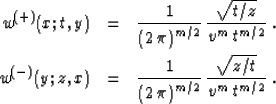




Next: Post-Stack Residual Migration
Up: EXAMPLES
Previous: Migration
An interesting example of a stacking operator is the hyperbola summation
used for time migration in the post-stack domain. In this case, the
summation path is defined as
|  |
(63) |
where z denotes the vertical traveltime, x and y are the
horizontal coordinates on the migrated and unmigrated sections
respectively, and v stands for the effectively constant
root-mean-square velocity Claerbout (1995b). The summation path
for the reverse transformation (demigration) is found from solving
equation (63) for z. It has the well-known elliptic form
|  |
(64) |
The Jacobian of transforming z to t is
|  |
(65) |
If the migration weighting function is defined by conventional
downward continuation Schneider (1978), it takes the following form,
which is equivalent to equation (44):
|  |
(66) |
The simple trigonometry of the reflected ray suggests that the cosine
factor in formula (66) is equal to the simple ratio between the
vertical traveltime z and the zero-offset reflected traveltime t:
|  |
(67) |
The equivalence of the Jacobian (65) and the cosine factor
(67) has important interpretations in the theory of Stolt
frequency-domain migration
Chun and Jacewitz (1981); Levin (1986); Stolt (1978).
According to equation (19), the weighting function of the
adjoint operator is the ratio of (66) and (65):
|  |
(68) |
We can see that the cosine factor z/t disappears from the adjoint
weighting. This is completely analogous to the known effect of
``dropping the Jacobian'' in Stolt migration
Harlan (1983); Levin (1994). The product of the
weighting functions for the time migration and its asymptotic inverse
is defined according to formula (9) as
|  |
(69) |
Thus, the asymptotic inverse of the conventional time migration has
the weighting function determined from equations (9) and
(66) as
|  |
(70) |
The weighting functions of the asymptotic pseudo-unitary operators are
obtained from formulas (34) and (35). They have the form
|  |
(71) |
| (72) |
The square roots of the cosine factor appearing in formulas
(71) and (72) correspond to the analogous terms in the
pseudo-unitary Stolt migration proposed by Harlan and Sword
1986.





Next: Post-Stack Residual Migration
Up: EXAMPLES
Previous: Migration
Stanford Exploration Project
9/11/2000


